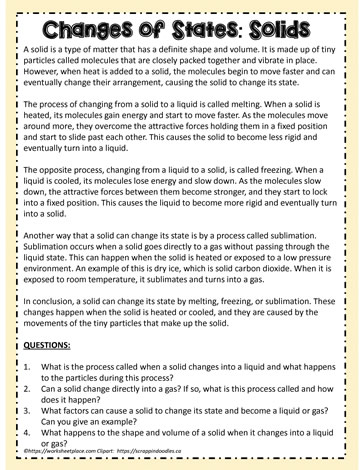| |||||
| Changes of State Reading: Solids For Google Apps | |||||
| A solid is a type of matter that has a definite shape and volume. It is made up of tiny particles called molecules that are closely packed together and vibrate in place. However, when heat is added to a solid, the molecules begin to move faster and can eventually change their arrangement, causing the solid to change its state. The process of changing from a solid to a liquid is called melting. The opposite process, changing from a liquid to a solid, is called freezing. Another way that a solid can change its state is by a process called sublimation. In conclusion, a solid can change its state by melting, freezing, or sublimation. These changes happen when the solid is heated or cooled, and they are caused by the movements of the tiny particles that make up the solid. Students in grade 4-6 will read this information on solids and then answer the questions. 1. What is the process called when a solid changes into a liquid and what happens to the particles during this process? 2. Can a solid change directly into a gas? If so, what is this process called and how does it happen? 3. What factors can cause a solid to change its state and become a liquid or gas? Can you give an example? 4. What happens to the shape and volume of a solid when it changes into a liquid or gas? | |||||

All worksheets are created by experienced and qualified teachers. Send your suggestions or comments.